1995 PONTIAC BONNEVILLE climate control
[x] Cancel search: climate controlPage 112 of 338
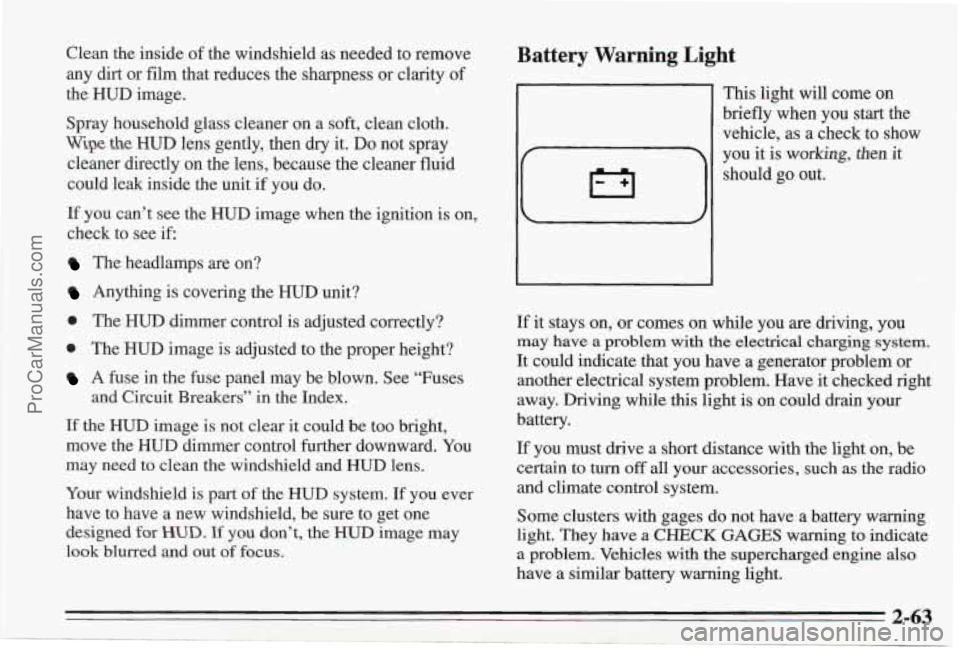
Clean the inside of the windshield as needed to remove
any dirt or film that reduces the sharpness or clarity of
the
HUD image.
Spray household glass cleaner on a
soft, clean cloth.
Wipe the HUD lens gently, then dry it. Do not spray
cleaner directly on the lens, because the cleaner fluid
could leak inside the unit if you do.
If you can’t see the HUD image when the ignition
is on,
check to see if
The headlamps are on?
Anything is covering the HUD unit?
0 The HUD dimmer control is adjusted correctly?
0 The HUD image is adjusted to the proper height?
A fuse in the fuse panel may be blown. See “Fuses
If the HUD image is not clear it could be too bright,
move the
HUD dimmer control further downward. You
may need to clean the windshield and HUD lens.
Your windshield is part
of the HUD system. If you ever
have to have a new windshield, be sure to get one
designed
for HUD. If you don’t, the HUD image may
look blurred and out of focus.
and Circuit Breakers”
in the Index.
Battery Warning Light
This light will come on
briefly when you start the
vehicle, as a check to show
If it stays on, or comes on while you are dnving, you
may have a problem with the electrical charging system.
It could indicate that you have a generator problem or
another electrical system problem. Have it checked right
away. Driving while this light
is on could drain your
battery.
If you must drive a short distance with the light on, be
certain to turn
off all your accessories, such as the radio
and climate control system.
Some clusters with gages do not have a battery
warning
light. They have a CHECK GAGES warning to indicate
a problem. Vehicles with the supercharged engine also
have a similar battery warning light.
2-63
ProCarManuals.com
Page 123 of 338
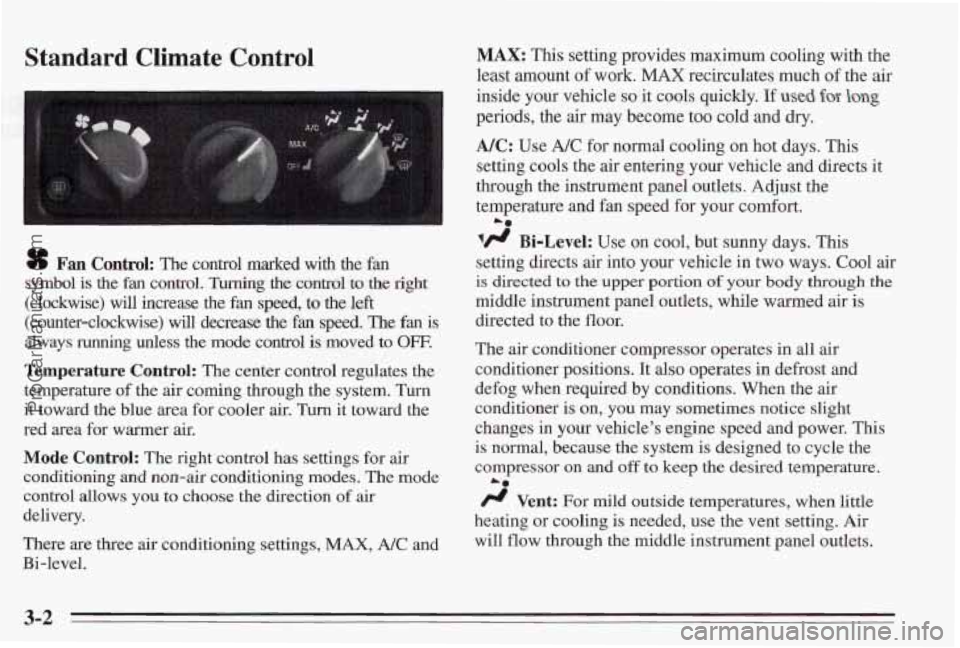
Standard Climate Control
sf Fan Control: The control marked with the fan
symbol is
the fan control. Turning the control to the right
(clockwise) will increase the fan speed, to the left
(counter-clockwise) will decrease the fan speed. The fan is
always running unless the mode control is moved to OFF.
Temperature Control: The center control regulates the
temperature
of the air coming through the system. Turn
it toward the blue area for cooler air.
Turn it toward the
red area for warmer air.
Mode Control: The right control has settings for air
conditioning and non-air conditioning modes.
The mode
control allows
you to choose the direction of air
delivery.
There are three air conditioning settings,
MAX, A/C and
Bi-level.
MAX: This setting provides maximum cooling with the
least amount
of work. MAX recirculates much of the air
inside your vehicle
so it cools quickly. If used for- long
periods, the air may become too cold and dry.
NC: Use A/C for normal cooling on hot days. This
setting cools the air entering your vehicle and directs it
through the instrument panel outlets. Adjust the
temperature
and fan speed for your comfort.
lfl Bi-Level: Use on cool, but sunny days. This
setting directs air into your vehlcle in two ways. Cool air
is directed to the upper portion of your body through the
middle instrument panel outlets, while warmed air is
directed to the floor.
The
air conditioner compressor operates in all air
conditioner positions. It also operates in defrost and
defog when required by conditions. When the
air
conditioner is on, you may sometimes notice slight
changes
in your vehicle’s engine speed and power. This
is
normal, because the system is designed to cycle the
compressor on
and off to keep the desired temperature.
/J Vent: For mild outside temperatures, when little
heating or cooling is needed, use the vent setting. Air
will
flow through the middle instrument panel outlets.
La
3-2
ProCarManuals.com
Page 125 of 338
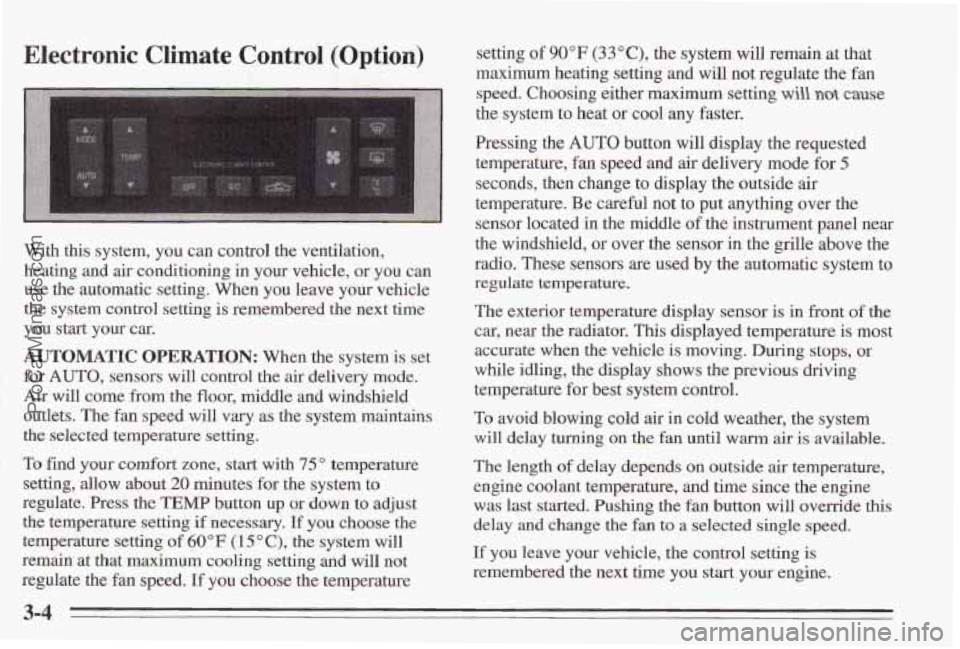
Electronic Climate Control (Option)
With this system, you can control the ventilation,
heating and
air conditioning in your vehicle, or you can
use the automatic setting. When
you leave your vehicle
the system control setting
is remembered the next time
you start your
car.
AUTOMATIC OPERATION: When the system is set
for
AUTO, sensors will control the air delivery mode.
Air will come from the floor, middle and windshield
outlets. The fan speed will
vary as the system maintains
the selected temperature setting.
To find your comfort
zone, start with 75" temperature
setting, allow about
20 minutes for the system to
regulate. Press the
TEMP button up or down to adjust
the temperature setting
if necessary, If you choose the
temperature
setting of 60°F (1 5 O C), the system will
remain at that maximum cooling setting and will not
regulate the fan speed.
If you choose the temperature setting
of 90°F (33"C), the system
will remain at that
maximum heating setting and will
not regulate the fan
speed. Choosing either maximum setting
will not cause
the system to heat or cool any faster.
Pressing the
AUTO button will display the requested
temperature, fan speed and air delivery mode for
5
seconds, then change to display the outside air
temperature. Be careful not to put anything over the
sensor located in the middle
of the instrument panel near
the windshield, or over the sensor in the
grille above the
radio. These sensors are used by the automatic system to
regulate temperature.
The exterior temperature display sensor is in front of the
car, near the radiator,
This displayed temperature is most
accurate when the vehicle is moving. During stops,
or
while idling, the display shows the previous driving
temperature for best system control.
To avoid blowing cold air in cold weather, the system
will delay turning on the
fan until warm air is available.
The length
of delay depeds on outside air temperature,
engine coolant temperature, and time since the engine
was last started. Pushing the
fan button will override this
delay and change the fan
to a selected single speed.
If you leave your vehicle, the control setting is
remembered the next time you start your engine.
3-4
ProCarManuals.com
Page 127 of 338
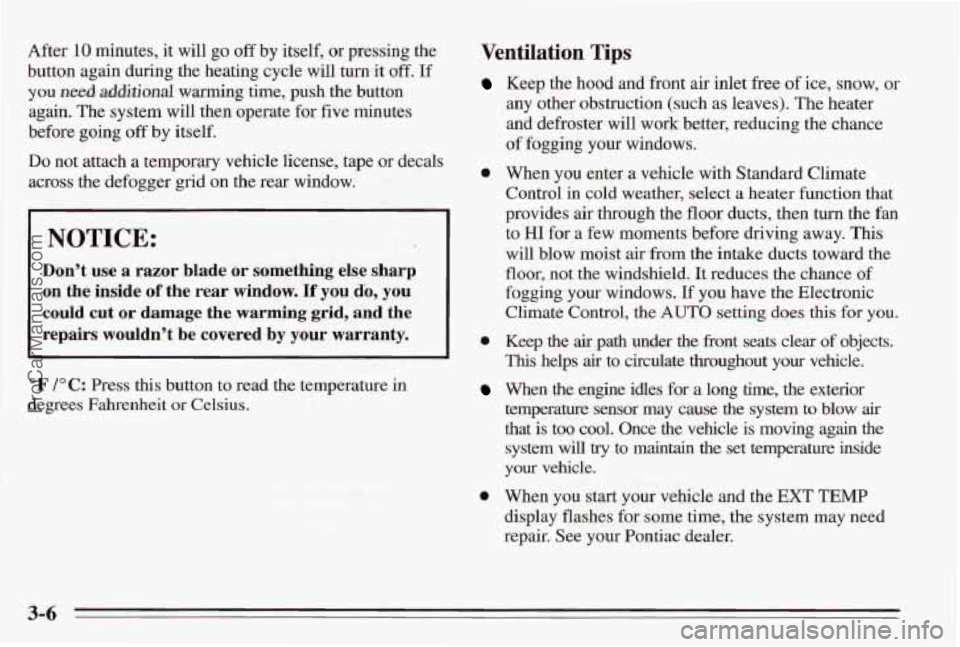
After 10 minutes, it will go off by itself, or pressing the Ventilation Tips
button again during the heating cycle will turn it off. If
you need additional warming time, push the button
again. The system will then operate for five minutes
before going
off by itself.
Do not attach a temporary vehicle license, tape or decals
across the defogger grid on the rear window.
Keep the hood and front air inlet free of ice, snow, or
any other obstruction (such as leaves). The heater
and defroster will work better, reducing the chance
of fogging your windows.
Control
in cold weather, select a heater function that
0 When you enter a vehicle with Standad Climate
NOTICE:
Don't use a razor blade or something else sharp
on the inside
of the rear window. If you do, you
could cut
or damage the warming grid, and the
repairs wouldn't be covered by your warranty.
OF /"C: Press this button to read the temperature in
degrees Fahrenheit or Celsius.
., .. .
provides air through the floor ducts, then turn the fan
to
HI for a few moments before driving away. This
will blow moist air from the intake ducts toward the
floor, not the windshield. It reduces the chance of
fogging your windows.
If you have the Electronic
Climate Control, the
AUTO setting does this for you.
0 Keep the air path under the fbnt seats clear of objects.
This helps air to circulate throughout your vehicle.
When the engine idles for a long time, the exterior
temperature sensor may cause
the system to blow air
that is too cool. Once the vehicle is moving again the
system
will try to maintain the set temperature inside
your vehicle.
0 When you start your vehicle and the EXT TEMP
display flashes for some time, the system may need
repair. See your Pontiac dealer.
3-6
ProCarManuals.com
Page 250 of 338
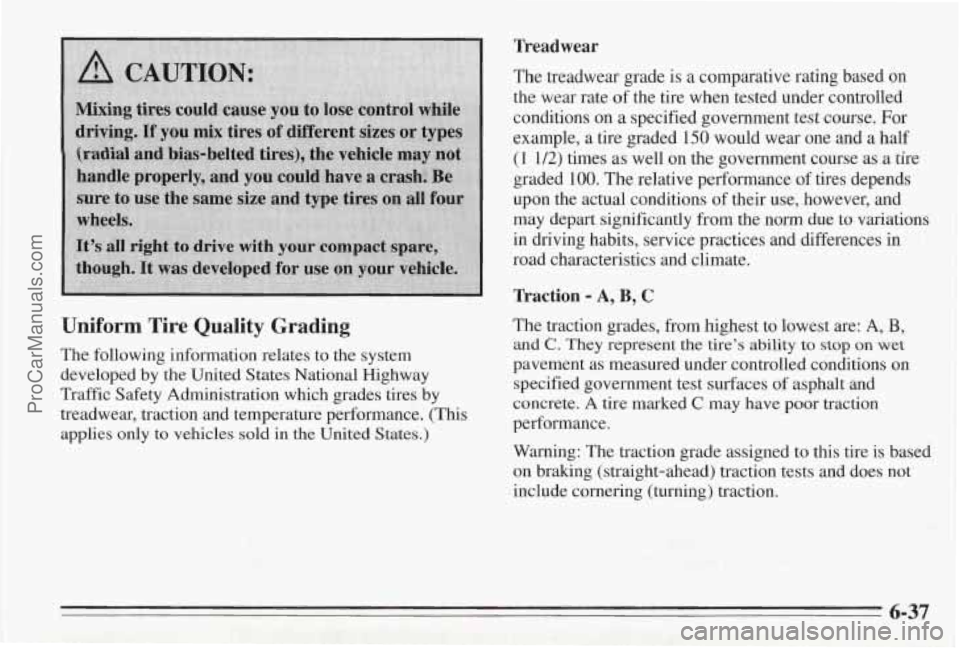
Treadwear
Uniform Tire Quality Grading
The following information relates to the system
developed
by the United States National Highway
Traffic Safety-Administration which grades tires by
treadwear, traction and temperature performance.
(This
applies only to vehicles sold in the United States.) The
treadwear grade is a comparative rating based on
the wear rate of the tire when tested under controlled
conditions
on a specified government test course. For
example, a tire graded
150 would wear one and a half
( 1 1/2) times as well on the government course as a tire
graded 100. The relative performance of tires depends
upon the actual conditions of their use, however, and
may depart significantly from the norm due to variations
in driving habits, service practices and differences in
road characteristics and climate.
Traction - A, B, C
The traction grades, from highest to lowest are: A, B,
and c. They represent the tire’s ability to stop on wet
pavement as measured under controlled conditions on
specified government test surfaces
of asphalt and
concrete. A tire marked C may have poor traction
performance.
Warning: The traction grade assigned to this tire is based
on braking (straight-ahead) traction tests and does not
include cornering (turning) traction.
6-37
ProCarManuals.com
Page 328 of 338
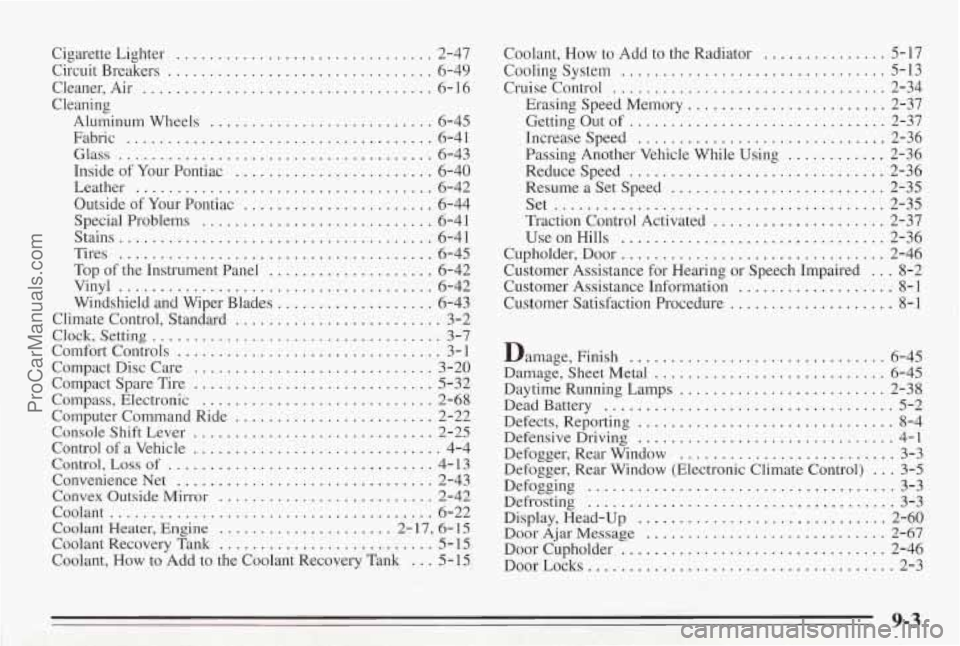
Cigarette Lighter . ... 2-47
Circuit Breakers
........ ......... 6-49
Cleaner. Air
................. ............. 6-16
Cleaning
Aluminum Wheels
........................... 6-45
Fabric
..................................... 6-41
Glass
...................................... 6-43
Inside
of Your Pontiac ........................ 6-40
Leather
.................................... 6-42
Outside of Your Pontiac
....................... 6-44
Special Problems
............................ 6-4 1
Stains ...................................... 6-41
Tires
...................................... 6-45
Top
of the Instrument Panel .................... 6-42
Vinyl
...................................... 6-42
Windshield and Wiper Blades
................... 6-43
Climate Control. Standard
......................... 3-2
C1ock.Settin.g
................................... 3-7
Comfort Controls
................................ 3- 1
Compact Disc Care ............................. 3-20
Compact Spare Tire
............................. 5-32
Compass. Electronic
............................ 2-68
Computer Command Ride
........................ 2-22
Console Shift Lever
............................. 2-25
Control
of a Vehicle .............................. 4-4
Control.
Loss of ................................ 4- 13
Convenience Net ............................... 2-43
Convex Outside Mirror
.......................... 2-42
Coolant
....................................... 6-22
Coolant Heater. Engine ..................... 2- 17. 6-15
Coolant Recovery Tank .......................... 5- 15
Coolant. How to Add to the Coolant Recovery Tank
... 5- 15 Coolant.
How to Add to the Radiator
. .... 5-17
Cooling System
................ ....... 5-13
Cruise Control
................... ......... 2-34
Erasing Speed Memory
...................... 2-37
Getting Out of
............................... 2-37
Increase Speed
.............................. 2-36
Passing Another Vehicle While Using
............ 2-36
Reducespeed
............................... 2-36
Resume
a Set Speed ..... .............. 2-35
Set
........................................ 2-35
Traction Control Activated
..................... 2-37
UseonHills
................................ 2-36
Cup holder. Door
................................ 2-46
Customer Assistance Information
................... 8-1
Customer Satisfaction Procedure
.................... 8-1
Customer Assistance for Hearing or
Speech Impaired
... 8-2
Damage. Finish
... ....... .... 6-45
Damage. Sheet Metal
............... .... 6-45
Daytime Running Lamps
......................... 2-38
Dead Battery
................................... 5-2
Defects. Reporting
............................... 8-4
Defensive Driving
............................... 4-1
Defogger. Rear Window
.......................... 3-3
Defogger. Rear Window (Electronic Climate Control)
... 3-5
Defogging ..................................... 3-3
Defrosting
..................................... 3-3
Display. Head-Up .............................. 2-60
Door Ajar Message
............................. 2-67
DoorCupholder ................................ 2-46
DoorLocks
..................................... 2-3
9-3
ProCarManuals.com
Page 329 of 338
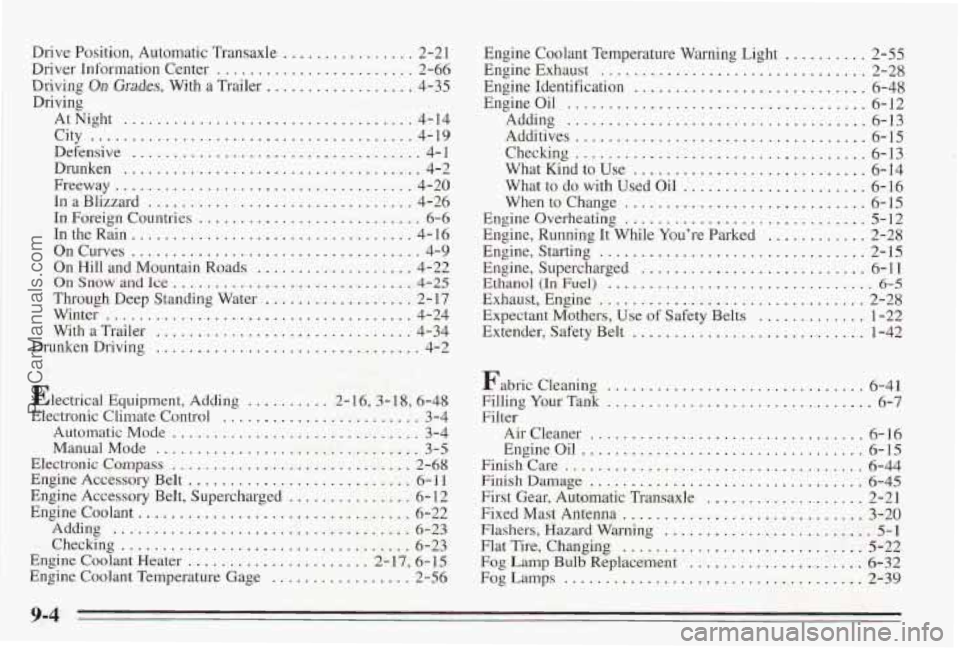
Drive Position. Automatic Transaxle ................ 2-21
Driver Information Center
........................ 2-66
Driving
On Grades. With a Trailer .................. 4-35
Driving AtNight
................................... 4-14
City
....................................... 4-19
Defensive
................................... 4-1
Drunken
.................................... 4-2
Freeway
.................................... 4-20
In a Blizzard ................................ 4-26
In Foreign Countries ........................... 6-6
In the Rain .................................. 4- 16
OnCurves
................................... 4-9
On Hill and Mountain Roads
................... 4-22
On Snow and Ice ............................. 4-25
Through Deep Standing Water .................. 2-17
Winter
..................................... 4-24
With a Trailer
............................... 4-34
Drunken Driving
................................ 4-2
Electrical Equipment, Adding
.......... 2-16, 3-18, 6-48
Electronic Climate Control
........................ 3-4
Automatic Mode
.............................. 3-4
ManualMode
................................ 3-5
Electronic Compass
............................. 2-68
Engine Accessory Belt
........................... 6- 11
Engine Accessory Belt, Supercharged ............... 6- 12
Engine Coolant
................................. 6-22
Checking ................................... 6-23
Engine Coolant Heater
...................... 2-17, 6-15
Adding
.................................... 6-23
Engine Coolant Temperature Gage
................. 2-56 Engine
Coolant Temperature Warning Light
.......... 2-55
Engine Exhaust ................................ 2-28
Engine Identification
............................ 6-48
Engineoil
.................................... 6-12
Adding
.................................... 6-13
Additives
................................... 6-15
Checking
................................... 6-13
What Kind to Use ............................ 6-14
What to do with Used Oil
...................... 6-16
Whentochange
............................. 6-15
Engine Overheating ............................. 5-12
Engine, Running It While You’re Parked
............ 2-28
Engine, Starting
................................ 2-15
Engine, Supercharged
........................... 6-11
Ethanol (In Fuel) ................................ 6-5
Exhaust, Engine ................................ 2-28
Expectant Mothers, Use of Safety Belts ............. 1-22
Extender, Safety Belt ............................ 1-42
Fabric Cleaning
............................... 6-41
FillingYourTank
................................ 6-7
Fi 1 ter Aircleaner
................................. 6-16
EngineOil .................................. 6-15
Finishcare
.................................... 6-44
Finish Damage ................................. 6-45
First Gear, Automatic Transaxle
................... 2-21
Fixed Mast Antenna
............................. 3-20
Flat Tire, Changing
............................. 5-22
Fog Lamp
Bulb Replacement ..................... 6-32
Flashers, Hazard Warning ......................... 5-1
FogLamps .................................... 2-39
9-4
ProCarManuals.com
Page 333 of 338
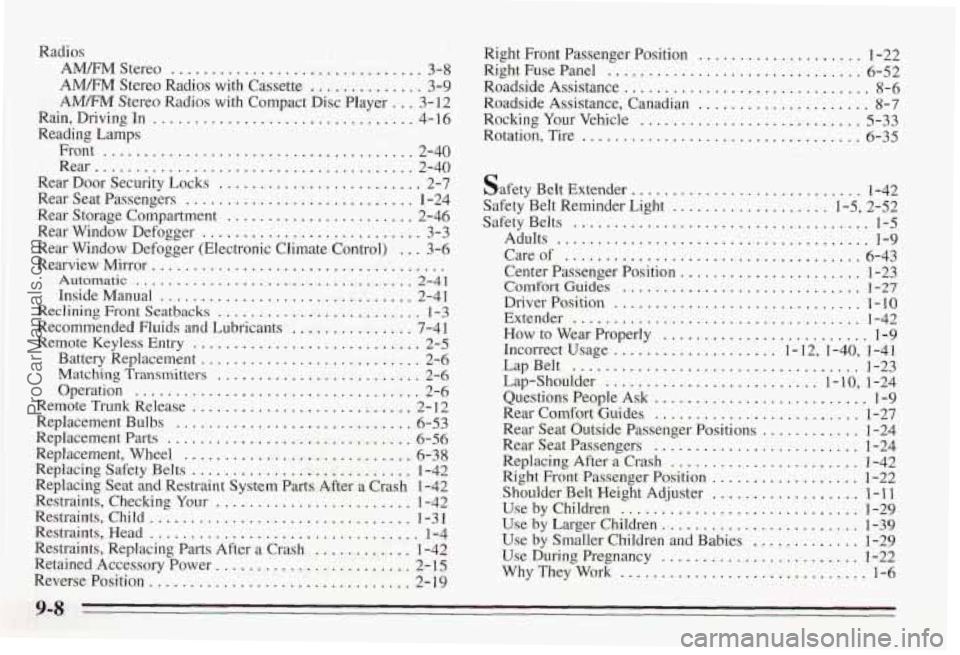
Radios
AM/FM Stereo ............................... 3-8
AMFM Stereo Radios with Cassette .............. 3-9
Rain. Driving
In ................................ 4- 16 AMm Stereo Radios with Compact Disc Player ... 3-12
Reading Lamps
Front
...................................... 2-40
Rear
....................................... 2-40
Rear Door Security Locks ......................... 2-7
Rear Seat Passengers
............................ 1-24
Rear Storage Compartment
....................... 2-46
Rear Window Defogger
........................... 3-3
Rear Window Defogger (Electronic Climate Control)
... 3-6
Rearview Mirror ....................................
Automatic .................................. 2-41
InsideManual ............................... 2-41
Reclining Front Seatbacks ......................... 1-3
Recommended Fluids and Lubricants ............... 7-41
Remote Keyless Entry
............................ 2-5
Battery Replacement
........................... 2-6
Matching
Transmitters ......................... 2-6
Operation
................................... 2-6
Remote Trunk Release
........................... 2- 12
Replacement Bulbs
............................. 6-53
Replacement Parts .............................. 6-56
Replacement. Wheel ............................ 6-38
Replacing Safety Belts ........................... 1-42
Restraints. Checking Your
........................ 1-42
Restraints. Child
................................ 1-3 1
Restraints, Head ................................. 1-4
Restraints, Replacing Parts After a Crash ............ 1-42
Retained Accessory Power
........................ 2- 15
Reverse Position ................................ 2- 19
Replacing Seat and Restraint System Parts After a Crash 1-42 Right Front
Passenger Position
.................... 1-22
Roadside Assistance
.............................. 8-6
Roadside Assistance, Canadian
..................... 8-7
Rocking Your Vehicle ........................... 5-33
Rotation, Tire .................................. 6-35
RightFusePanel ............................... 6-52
Safety Belt Extender
............................ 1-42
Safety Belt Reminder Light
................... 1.5. 2.52
Safety Belts
.................................... 1-5
Adults ...................................... 1-9
Careof .................................... 6-43
Center Passenger Position ...................... 1-23
Comfort
Guides ............................. 1-27
Driver Position .............................. 1-10
How to Wear Properly
......................... 1-9
Incorrect Usage
.................... 1 - 12, 1-40, 1-41
Lap-Shoulder .......................... 1-10. 1-24
Questions People Ask .......................... 1-9
Rear Comfort Guides ......................... 1-27
Rear Seat Outside Passenger Positions ............ 1-24
Rear Seat Passengers
......................... 1-24
Replacing After a Crash
....................... 1-42
Right Front Passenger Position
.................. 1-22
Shoulder Belt Height Adjuster
.................. 1-11
Use by Children ............................. 1-29
Use by Larger Children
........................ 1-39
Use by Smaller Children and Babies ............. 1-29
Use During Pregnancy
........................ 1-22
Extender
.............,..................... l-42
LapBelt ................................... 1-23
WhyTheyWork
......,..,.................... l-6
9-8
ProCarManuals.com